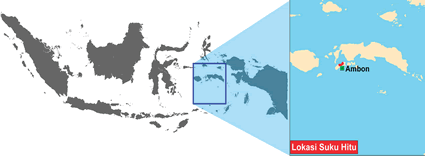The Hitu live in five village areas along the north coast of Ambon island: Wakal, Hila, Hitu, Mamala and Morela. Hitu can be reached by land or sea.
In the past, Hitu village formed the commercial center and goods distribution point for Ambon island. Since the regional violence of 2000 and following, public transport usually comes and goes once daily from the city of Ambon.
Hitu stories recount that in the past, the Hitu lived at the edge of the jungle. Later developments caused them to begin moving out of the jungle and building beach-side houses. The Hitu people use Hitu language, consisting of various dialects.
Most Hitu live near the sea in beach-side houses, but some live along the road leading to the city of Ambon. The Hitu area has ample sources of fresh water, flowing from fissures in limestone rocks.
Many of the Hitu combine farming and fishing for income. The Hitu cultivate cloves, nutmeg, sago palm, coconut and various other spices and fruits. Despite this, their fertile land, governed by tribal law, remains underutilized.
Some Hitu work as teachers or other government employees. Many Hitu women work as fish sellers.
Islam first entered the Maluku area in Hitu village. For this reason, nearly all Hitu people are Muslim. They believe that later they will be judged both on their knowledge of the Koran and on their good works. But like most Muslim people in Maluku, the Hitu combine Islam with even more ancient animism.
The Hitu need more widespread access to formal education. The Hitu area includes one agricultural school, one government Islamic school and the private Islamic boarding school, Madrasah Tsanawiyah. Even where schools exist, many finish only elementary school.
Apart from needing formal education, the Hitu also need general knowledge about health and public sanitation. The Hitu society needs good leadership and direction to develop their physical health and their agricultural potential.
Appropriate small-scale technology could also help them become a more productive society. They have very few chances to improve their job skills. Lack of electricity and dependable clean water supply also hinder development of Hitu society.
Ask God to send laborers to the Hitu who will share the gospel with them and help them develop education, agriculture, infrastructure and appropriate technology.
Pray for a spiritual hunger among the Hitu. Ask the Holy Spirit to give them the discernment to recognize that Jesus Christ offers the only way to the Heavenly Father.
Pray for the translation of the Bible and other Christian resources into the Hitu language.
Pray for a Disciple Making Movement to emerge among the Hitu that will result in multiplying disciples and churches.
Scripture Prayers for the Hitu in Indonesia.
https://en.wikipedia.org/wiki/Hitu_language#:~:text=Hitu%20is%20an%20Austronesian%20language%20of%20the%20Central,Hila%2C%20are%20said%20to%20have%20their%20own%20dialect.
| Profile Source: Joshua Project |











